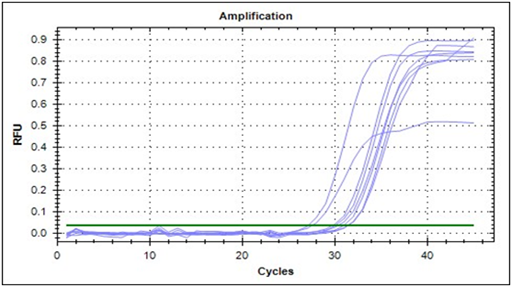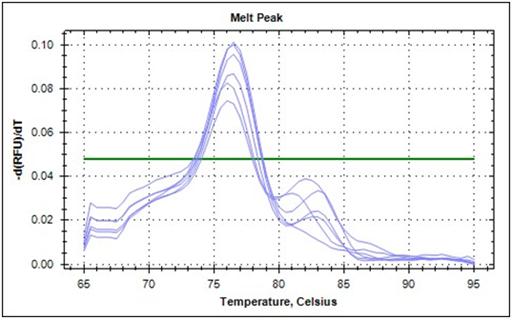Journal of
eISSN: 2373-6453


This study was carried out to evaluate some epidemiological features of HECV infection by using real-time fluorogenic quantitative reverse transcription polymerase chain reaction assay based on SYBR Green I die in detection of CoVs. Both virus species (HECV-4408 and BCoV) detected by the same neocleocapsid (N) gene primer fewer than 98% similarity according to NCBI with product size 124bp.
The technique has not been established for detection of HECV-4408 worldwide, and in detection of BCoVs in Iraq. One hundred fresh stool specimens were collected from hospitalized children between December 2012 to May 2013 in Maternal and Children’s Hospital and dispensaries in districts and subdistricts of Al- Diawaniyia province, children showed acute diarrhea with some respiratory signs, all stool were examined by routine diagnosis methods against pathogenic bacteria (E. coli, Shigella, and Salmonella spp.) and parasitic invasion of Cryptosporidium spp.
The diagnostic examination of entero-pathagenic bacteria in fecal samples has been established just to take unidea about the occurrence of bacterial infection with coronavirus, while the positive cryptosporidium spp. samples submitted to molecular test as possible mix infection with coronavirus. HECV-4408 has been detected via reverse transcription realtime-qPCR in 18 out of 41 children’s stool despite the infection with HCEV-4408 being found in the center of province and other districts was 50%-60%, remains the highest percentage for the spreading of infection with the virus in rural areas up to 100%. Infection percentage in females reached to 52.2% while in males lowered to 33.3%. And 50%-57.1% of children infected with HECV-4408 they were at age ≥6 years but the infection was low in neonates 15.3%. The peak of HCEV-4408 activity often appeared during April 60% in comparison with January 50%, March 46.7% and February 40%.
Keywords:HECV-4408; Epidemiological features of HECV; Molecular detection of CoVs
CoVs are common human pathogens affecting children and adults worldwide with most individuals becoming infected in the first few years of life.1 And their role in enteric infections is less clear, even though CoVs-like particles have been seen by electron microscopy in stool samples from patients with diarrhea, they have been also found in healthy individuals.2
Generally, CoVs have been displayed marked winter seasonality between the months of December and April and were not detected in summer months, which are comparable to the pattern seen with influenza viruses,3 with a short incubation time,4 in temperate climates.5 HECV-4408 is discovered causative agent isolated firstly from a child with acute gastroenteritis, and it was antigenically and genetically more closely related to bovine coronavirus (BCoV) than to human coronavirus OC43.6
Aims of study
Primers A specific oligonucleotide primers set by using the complete sequence of Nucleocapsid gene of Human/Bovine Enteri Coronaviruses GenBank No. (NC_003045.1) which have a similarity at present 98% according to NCBI plast analysis, using NCBI Gene-Bank and Primer 3 online and provided by (Bioneer Company, Korea) as following forward / ATTTGCAGAGGGACAAGGTG & reveres / TAGCAATTGACGCTGGTTGC have 124bp product size Viral RNA was extracted from 41 children stools by using AccuZolTM Total RNA extraction kit (Bioneer, Korea) and done according to company instructions. cDNA synthesis a total RNA that extracted from stool samples were used in cDNA synthesis step by using AccuPower® RocktScript RT PreMix kit. Real-Time PCR master mix was prepared by Real-Time PCR detection kit (AccuPower→ GreenStarTMqPCRPreMix).
Based on the unique biological properties and the more distant relatedness of strains HECV-4408 / BCoVs, a universal published primer that had been developed to detect BCoVs and to determine the cross molecular -reactivity of HECV-4408, by targeting of the N gene (nucleocapsid gene) that was conserved among HECV-4408 / BCoV strains was used, As showed in the Figures (1-4). The important advantages of SYBR Green I over other real-time PCR detection formats are;

Figure 1 Reverse Transcription Real-Time PCR amplification plot shown the positive results of HECV-4408 in children samples.

Figure 2 Reverse Transcription Real-Time PCR amplification log plot shown the positive results of HECV-4408 in children samples.

Figure 3 Reverse Transcription Real-Time PCR melt curve shown the positive results of HECV-4408 in children samples.

Figure 4 Reverse Transcription Real-Time PCR melt peak shown the positive results of Human enteric coronvirus-4408 in children samples.
The results of molecular detection by Real time qRT-PCR of HECV-4408 in children according to study districts and regions in AL-Diwaniyia province, showed the total percentage of infection was 18 out of 41(43.9%). In districts city center, Hamza, Afak, and Shamyia were 50%, 60%, 60%, 50% respectively, the highest percent rate in Hamza and Afak 60%while the lowest percent rate incity center and Shamyia 50%. In sub districts the results in Shafeyia, Albdeer, Dughara, and Sumer were 33.3%, 25%, 0, 100%, respectively.
The highest percentage rate in Sumer 100% whiles the lowest percentage rate in Albdeer 25%. There was significant differences (p<0.05) between Shafeyia and Albdeer, Dughara, and Sumer, respectively. Between Albdeer and Sumer, Dughara respectively, between Sumer and Dughara. The positivity percentage of HECV-4408 in districts was reached to 60%. Whereas, in regions was higher to 100%, this may indicate for a large number of children about 43.9% are faced with the danger of HECV-4408 infection associated diarrhea or respiratory syndrome. Increasing in the infection rate of HECV-4408 within areas could be due to the fact that, peoples in rural areas keep touch with animal’s population.
This finding is in agreements with the findings of6 that have been reported a group 2 human coronavirus designated HECV-4408 isolated from a child with acute diarrhea lived in a rural area with the opportunity for contact with cattle or manure. The results of HEV-4408 infection according to children genders showed the highest positivity rate 52.2%was in females and the lowest positivity rate in males 33.3%. Statistically there was a significant difference (p< 0.05) between males and females. A study showed that, HECV-4408 infections in children, have a significant difference between males and females, the females showed highest positivity percentage 52.1%, whereas 33.3% was the positivity percentage for males. In fact, in the case of viral infection in general, this difference in susceptibility between males and females was shown for different viruses.9 For many years the concept of sex-based (or gender based) differences in host response to infection has been studied and appears to be highly related to differences in immunological capacities between males and females.10
Furthermore, it appears now that even though the relative importance of different factors may vary with the type of infection, X-linked genes, hormones, immunity and, at least in humans, societal context are among the factors that explain this sex-based difference.
Even though it remains difficult to clarify evidence on how the different factors make a difference between genders, studies aimed to addressing the question appear to more and more link specific hormones such as androgens in males and estrogens in females9,11 host innate immunity (expression of cytokines and of pattern recognition receptors such as toll-like receptors (TLR)12,13 as well as acquired immunity involving T and B lymphocytes (Klein, 2000) to explains, also the children in urban areas 42% are more likely to receive the recommended treatment than those living in rural areas 38%. Similarly, children from the wealthiest households 40% are more likely to receive the recommended treatment than those from the poorest households 34 % according to the reports of.14
The results of HECV-4408 infection according to the age groups showed that (1day_5months) and (< 5 month_3 years, and < 3_6 years) were 15.3%, 57.1%, and 50% respectively, the highest percent rate in childes aged < 5 month_3 years 57.1% and the lowest percent rate was in 1day_5months. There were significant differences (p< 0.05) between children in ages 1day_5months and < 5 month_3 years, < 3_6 years respectively. No significant differences on (p< 0.05) between children in ages< 5 month_3 years and < 3_6 years.
The children included in our study were under six years of age, there was no significant differences between children <5months-3years and <3_6years, this results in agreements with15,16 they were proved that coronaviruses are common human pathogens affecting children and adults worldwide with most individuals becoming infected in the first few years of life. No study controlling for age and month of illness has demonstrated an epidemiologic association between infections with HECV-4408. But there is one reason for significant difference and the lowest positivity percentage at (1day-5 months) it was the presence of maternal antibodies directed to HCoVs in younger infants.17
The results showed that HECV-4408 infections are unequal distributed throughout cold and warm months, the highest percentage recorded in April 60%, because human coronaviruses infections have also been strongly associated with seasonality distribution during warmer seasons in agreements with previously published studies.18,19 Followed by January 50%. Those results agreed with2, 5, 20, 21 they were proved that human coronavirus infections occur mainly in winter, with a short incubation time, that also explain the disappearing of viral infection evidence during December.
Reverse transcription real time qRT-PCR results
Amplification plots represent 8 positive samples; the results showed different positive reaction cycles of threshold (Ct), they started reactions at 27, 28, 29, and 30 respectively. The amplification started from the Ct 26 and ended at 30.
Syber Green I based real-time PCR is a sequence independent assay that requires conduction of a melt curve analysis on the PCR products. Specific amplification of the HECV-4408 target sequence was identified by the generation of a melt peak at 78.35 _C _ 0.26. Specificity of the reaction was further evaluated for cross reactivity against different viruses that show symptomatic or genetic relationship with HECV-4408.
None.
None.

© . This is an open access article distributed under the terms of the, which permits unrestricted use, distribution, and build upon your work non-commercially.
 World Malaria Day, observed annually on April 25SUP>th. The purpose of this day is to raise awareness about the global struggle to combat malaria, highlighting the need for continued research, prevention, and treatment strategies to eradicate this deadly disease. So, it is an opportunity to all the researchers to submit your interesting papers on raising the approachability on modern vaccine development, advances in disease control, prevention and eradication and the submissions received till April 25th, 2024 will be offered a best discount of 30% for publication in Journal of Human Virology & Retro virology.
World Malaria Day, observed annually on April 25SUP>th. The purpose of this day is to raise awareness about the global struggle to combat malaria, highlighting the need for continued research, prevention, and treatment strategies to eradicate this deadly disease. So, it is an opportunity to all the researchers to submit your interesting papers on raising the approachability on modern vaccine development, advances in disease control, prevention and eradication and the submissions received till April 25th, 2024 will be offered a best discount of 30% for publication in Journal of Human Virology & Retro virology.